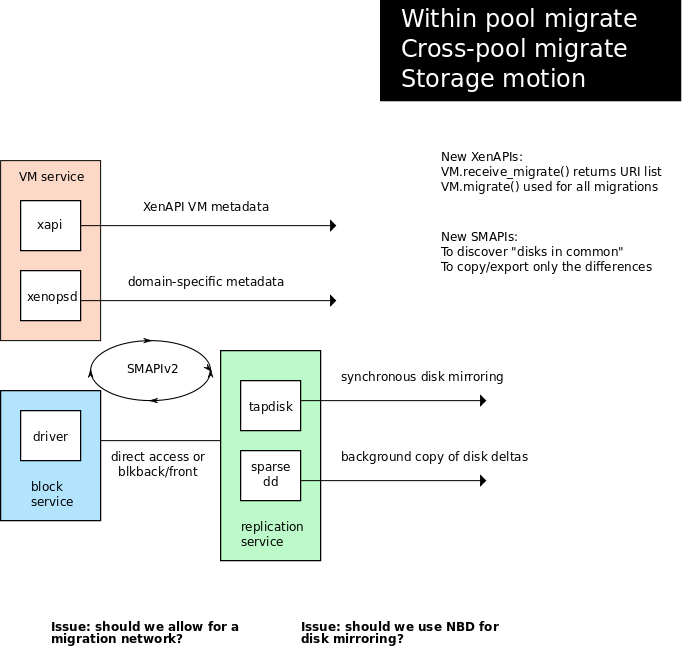CrossPoolMigrationv3: Difference between revisions
From Xen
Jump to navigationJump to search
Dave.scott (talk | contribs) No edit summary |
Dave.scott (talk | contribs) No edit summary |
||
| Line 1: | Line 1: | ||
This page describes a possible design for Cross-pool migration (which also works for within-pool migration with and without shared storage). |
This page describes a possible design for Cross-pool migration (which also works for within-pool migration with and without shared storage). |
||
This design has the following features: |
|||
# disks are replicated between the two sites/SRs using a "replication service" which is aware of the underlying disk structure (e.g. in the case of .vhd it can use the sparseness information to speed up the copying) |
|||
# the mirror is made synchronous by using the *tapdisk* "mirror" plugin (the same as used by the existing disk caching feature) |
|||
# the pool-level VM metadata is export/imported by xapi |
|||
# the domain-level VM metadata is export/imported by xenopsd |
|||
See the following diagram: |
|||
[[File:components3.png]] |
[[File:components3.png]] |
||
This design has the following advantages: |
|||
# by separating the act of mirroring the disks (like a storage array would do) from the act of copying a running memory image, we don't need to hack libxenguest. There is a clean division of responsibility between managing storage and managing running VMs. |
|||
# by creating a synchronous mirror, we don't increase the migration blackout time |
|||
# we can re-use the disk replication service to do efficient cross-site backup/restore (ie to make periodic VM snapshot and archive use an incremental archive) |
|||
Revision as of 11:45, 3 January 2012
This page describes a possible design for Cross-pool migration (which also works for within-pool migration with and without shared storage).
This design has the following features:
- disks are replicated between the two sites/SRs using a "replication service" which is aware of the underlying disk structure (e.g. in the case of .vhd it can use the sparseness information to speed up the copying)
- the mirror is made synchronous by using the *tapdisk* "mirror" plugin (the same as used by the existing disk caching feature)
- the pool-level VM metadata is export/imported by xapi
- the domain-level VM metadata is export/imported by xenopsd
See the following diagram:
This design has the following advantages:
- by separating the act of mirroring the disks (like a storage array would do) from the act of copying a running memory image, we don't need to hack libxenguest. There is a clean division of responsibility between managing storage and managing running VMs.
- by creating a synchronous mirror, we don't increase the migration blackout time
- we can re-use the disk replication service to do efficient cross-site backup/restore (ie to make periodic VM snapshot and archive use an incremental archive)

